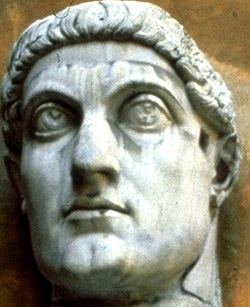Constantine the Great
Truly deserving of the title "great" it is no exaggeration to say that the world may well have been a different place, and history taken another course entirely had it not been for the life of Constantine.
His father, Constantius Chlorus, was Cæsar of the west and had been so appointed by Diocletian, who had decided in 286 CE. that the empire was too large and unwieldly to be ruled by one man and so had divided it into two separate but "united" sections. (By the way, just for trivia's sake, it is from this act that we have today the so-called Royal "we", in which the monarch refers to himself/herself in the plural form). In 306 Constantius travelled to Britain from France to quell an uprising of the Picts. Constantine who had not long previously joined his father as a teen-ager, having been held as a - possibly mild - hostage in the eastern court, to ensure the "good behaviour" of his father, had recently escaped from what may have been a potential assassination plot. Together they put down the revolt and almost immediately Constantius died. In an act of what amounted to usurpation, Constantine, with considerable support from the army, in which he had not only distinguished himself but also proved to be popular, had himself proclaimed one of the Augusti in the city of York, northern England, in his father's stead. He maintained a low profile for 4-5 years, while his rivals in the east indulged in internecine quarrels. Then, late in 311, he felt the time was right to put into motion his ambitions to reunite the empire - with himself as emperor. In the summer of 312 he set out eastwards at the head of his armies. Just outside Rome on 28 October, where the road crosses the Tiber at the Milvian Bridge, the two armies, Constantine's and Maxentius' faced each other. It was here, just before the battle, that Constantine is said to have had a vision in which he saw in the heavens a cross accompanied by the words
In hoc signo vinces, "With this sign conquer".
Conquer he did, and entered Rome in triumph. The empire was reunited and the Senate erected a Triumphal Arch in his honour.
As the next two decades progressed Constantine ruled increasingly from the east, defeating the remaining, weakened opposition and finally conquering Byzantium from his last rival, Licinius. Eventually, in 326 he moved the seat of empire from Rome, which had become more and more badly placed geographically for the task, to Byzantium, which he now rebuilt into a magnificent new city. The city was consecrated on Monday 11 May, 330, in the rebuilt church of Hagia Eirene - the Church of the Holy Peace. And so was born the city of Constantinople, to remain so with that name throughout the centuries until, in 1926 modern Turkey, under Mustapha Kemal (Attaturk) changed the name to Istanbul and moved the capital to Ankara - ancient Ancyra.
Gradually becoming more and more favourably disposed towards Christianity, Constantine confirmed old, and promulgated new laws and edicts, relaxing earlier anti-Christian legislation and actual barbaric persecutions from the rule of Diocletian. It was under Constantine that the pagan Empire of Rome became officially Christian although he himself - probably for reasons of political expediency, remained unbaptised until literally on his deathbed. Constantine died 22 May 337, seven years and eleven days after the official founding of his city.
For a brilliant and highly readable history of the Byzantine Empire read John Julius Norwich's three-volume masterpiece "Byzantium"
Back to the Byzantine Empire
Back to Home Page
